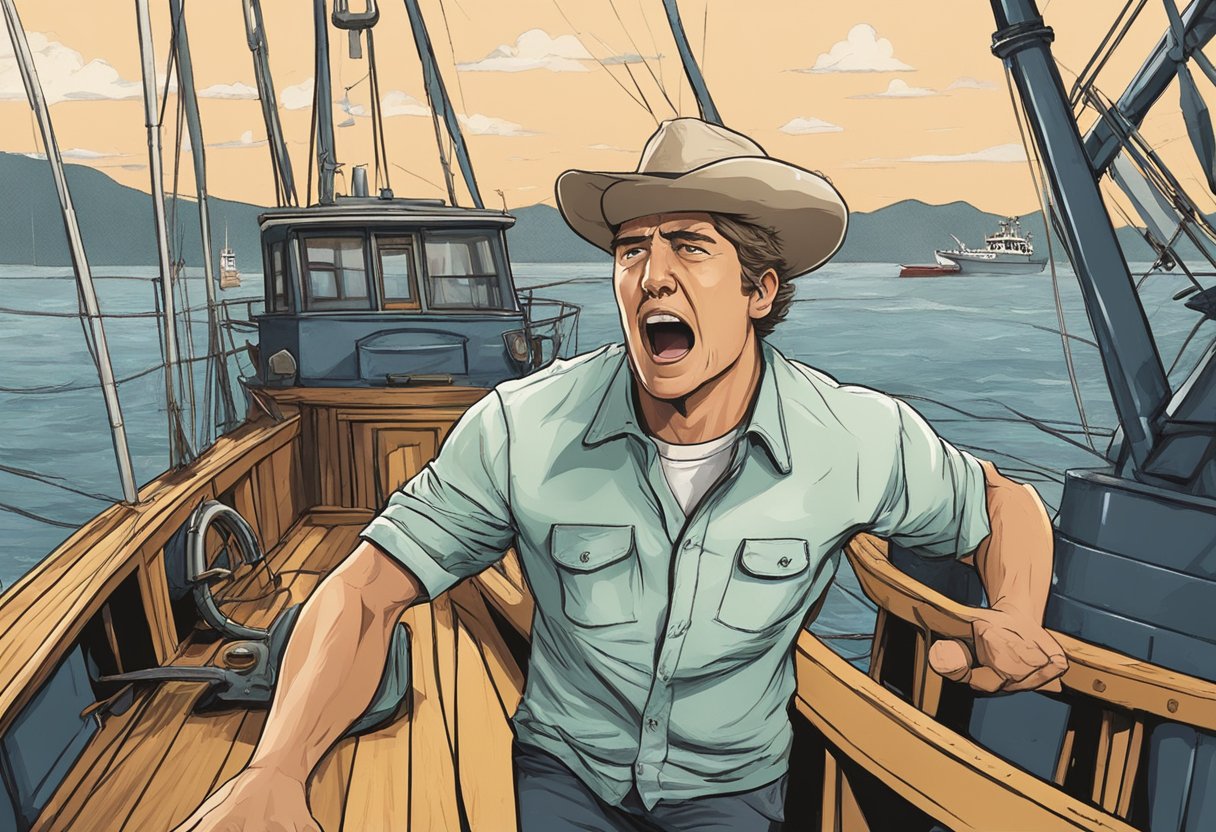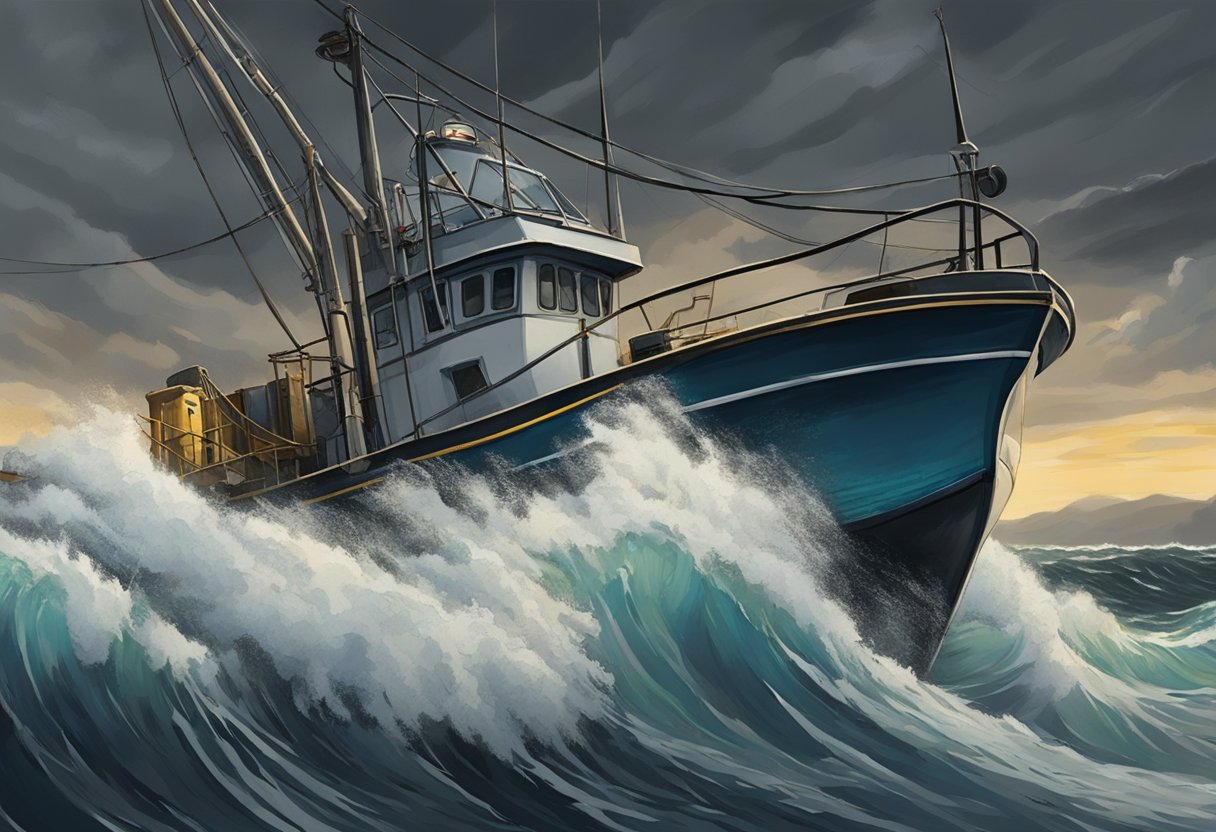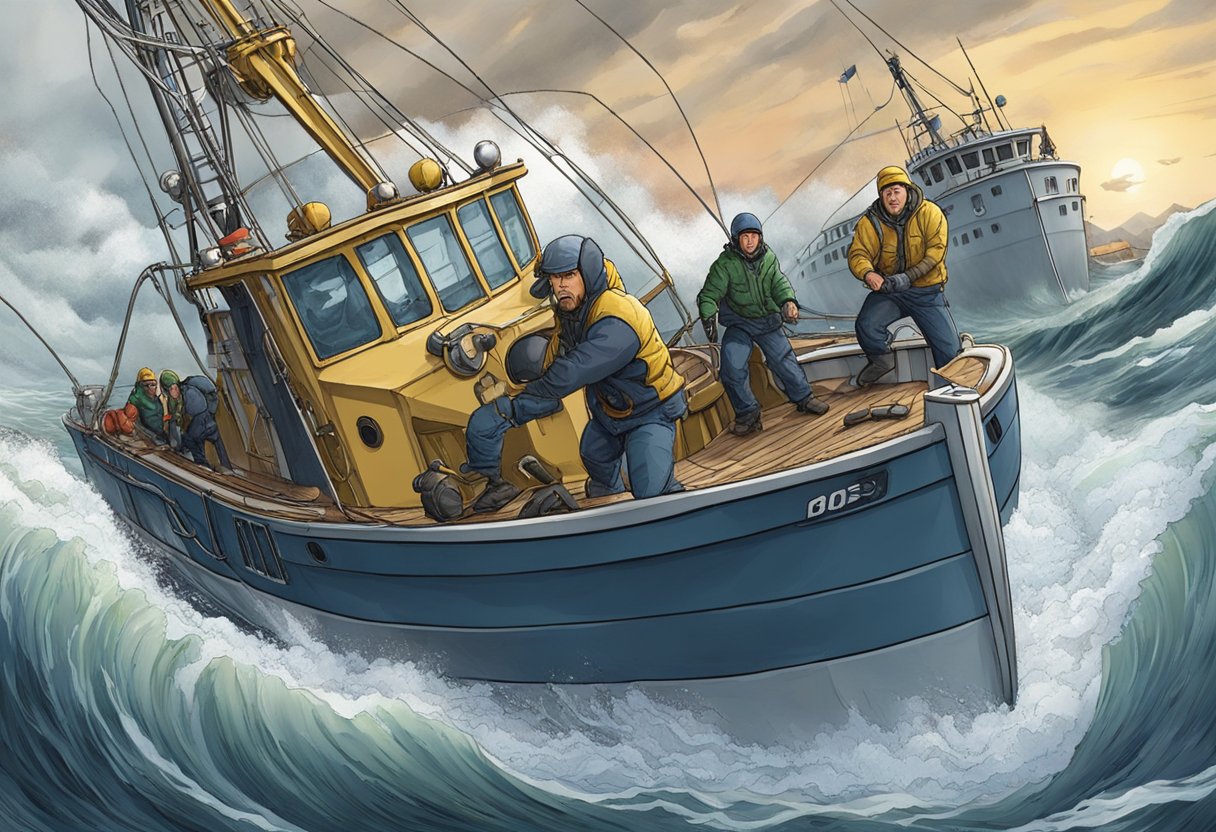Jake Anderson’s demeanor on “Deadliest Catch” has been a subject of interest among fans, as his bouts of anger and frustration on the show have often been evident. As a seasoned fishing captain on the FV Saga, Anderson has been a part of the Discovery Channel’s documentary series since 2007, navigating the treacherous Bering Sea. The stress and high stakes of crab fishing in these unforgiving waters are well-documented and can take a toll on even the most experienced fishermen.

Anderson’s intense reactions and emotions are not without cause, as the challenges of crab fishing are manifold. The extreme environmental conditions, coupled with the dangerous nature of the work and the pressure to succeed, create a high-tension atmosphere aboard any crab fishing vessel. For captains like Anderson, maintaining the crew’s morale while ensuring a profitable catch can be a serious source of stress.
Moreover, Anderson’s personal life has faced tragic turns that have played out in front of the “Deadliest Catch” audience, adding to the emotional background against which his professional endeavors unfold. Loss and personal struggles have intersected with his career, potentially influencing his on-screen persona and contributing to the moments of anger observed on the show. It’s these human elements that round out the portrayal of a captain dealing with the dual storms of nature and life.
So, let’s talk about why is Jake so mad Deadliest Catch.
Content Compass
Overview of Deadliest Catch

“Deadliest Catch” is a reality television series that airs on the Discovery Channel. The show premiered in April 2005 and has since captivated viewers with its gripping portrayal of deep-sea fishing expeditions in the treacherous waters of the Bering Sea.
Set primarily around the town of Dutch Harbor in Alaska, “Deadliest Catch” follows the lives of crab fishermen aboard various fishing vessels during the Alaskan king crab and snow crab fishing seasons. The show offers a glimpse into the challenging conditions these fishermen face, including severe weather and the inherent dangers of the profession, which justify the show’s title.
The series emphasizes the endurance, skill, and strong camaraderie required to undertake such a high-risk occupation. Camera crews aboard the ships capture every aspect of the journey, from tense moments of severe weather navigation to the triumph of a successful catch.
The personalities of the crab fishermen are a focal point of “Deadliest Catch,” with their interpersonal dynamics and reactions to the stresses of crab fishing being central themes. This human element contributes significantly to the show’s ongoing popularity.
Table 1: Key Components of “Deadliest Catch”
| Component | Description |
|---|---|
| Setting | Bering Sea, Alaska |
| Focus | Crab Fishing |
| Dangers | Severe weather, risk of injury or death, exhausting work |
| Themes | Perseverance, danger, camaraderie, ocean conservation |
| Notable Elements | Real-time capture of events, personal stories of the fishermen |
The series has received numerous accolades for its raw and authentic portrayal of the fishing industry and the people who brave the elements to make a living.
Who Is Captain Jake Anderson?
Captain Jake Anderson is a prominent figure in the world of commercial fishing and reality television. He is a fourth-generation fisherman, which signifies a deep-rooted family legacy in the fishing industry. Anderson rose to fame as one of the fearless captains on the Discovery Channel’s documentary series, “Deadliest Catch.”
Born on September 16, 1980, Jake’s career on television began when he was hired as a greenhorn by Captain Sig Hansen aboard the Northwestern in 2007. Since then, he has captained the fishing vessel F/V Saga, proving his mettle and expertise in one of the world’s most challenging professions.
- Notable Achievements:
- Started on “Deadliest Catch” in Season 3
- Became the captain of the F/V Saga
- Authored the book “Relapse”
Throughout his tenure on the show, Anderson has navigated not only the treacherous Bering Sea but also personal tragedies, which have been featured in various episodes, adding layers to his on-screen persona. Balancing his role as a captain and a television personality, Anderson’s life at sea is one of determination and resilience. Despite the hardships he has faced, his passion for fishing and dedication to his craft have solidified his reputation as a respected captain within the commercial fishing community.
He and captain Keith Colburn are definitely two of the biggest stars of the show.
The Saga’s Journey on the Show

The F/V Saga has been an integral part of “Deadliest Catch,” facing numerous challenges under Captain Jake Anderson’s leadership. Its voyage mirrors the trials faced by many in the perilous waters of crab fishing.
Voyage and Challenges
The Saga embarked on its journey in the third season, navigating the treacherous Bering Sea. The crew has contended with fierce storms, equipment failures, and the inherent danger that comes with one of the world’s deadliest professions. These dangers have tested the Saga and its crew, showcasing the relentless nature of their occupation.
- Weather: Extreme weather patterns have frequently jeopardized the safety of the vessel and its crew
- Mechanical Issues: Vital equipment breakdowns have posed significant risks and delays
- Sea Conditions: Unpredictable sea conditions have led to precarious situations, amplifying the challenges faced
Jake’s Leadership and Responsibilities
Jake Anderson assumed command of the Saga as a young captain, thrust into a role laden with responsibility. His leadership has been characterized by a hands-on approach, as he strives to motivate his crew and maintain the viability of their operations.
- Decision Making: Captain Anderson’s decisions often spell the difference between a successful haul and a perilous setback
- Crew Management: Ensuring the well-being of his crew while keeping morale high is a constant balancing act for the captain
- Financial Pressure: The burden of meeting quotas and navigating the economic aspects of running a fishing vessel weigh heavily on his shoulders
The Saga’s journey under Jake Anderson’s command is a testament to the demanding nature of crab fishing, highlighting both the human element and the unpredictability of the sea.
Crab Fishing in Alaska
Crab fishing in Alaska, particularly in the Bering Sea, is one of the most challenging and hazardous occupations in the world. The Bering Sea is notorious for its perilous waters, which are characterized by frigid temperatures, violent storms, and icy conditions. This environment presents significant risks for the fishing crews who brave these waters in pursuit of lucrative catches such as king crab and snow crab.
Seasons and Regulations:
- King Crab: Harvested during the fall, typically October and November
- Snow Crab: Caught later in the year, usually starting in January
Key Challenges:
- Icy deck conditions
- Heavy machinery operation
- Potential for severe weather
Safety Measures:
- Use of proper survival gear and suits
- Training for emergency situations
- Mandatory compliance with U.S. Coast Guard regulations
Fishermen in Alaska’s crabbing industry must be well-prepared and vigilant to survive the extreme working conditions. Each crew member’s role is vital, from navigating the boat to handling the crabs, all while maintaining a watchful eye on the unpredictable Bering Sea. Despite advancements in technology and safety, the threat of rogue waves, hypothermia, and equipment accidents remains ever-present, deserving the respect and caution from all who engage in this formidable pursuit.
Jake Anderson’s Personal Life
Jake Anderson’s journey on “Deadliest Catch” has been marked by notable family-related challenges and a struggle with addiction, all of which have had a profound impact on his career as a fisherman and his personal development. Let’s talk more about why is Jake so mad Deadliest Catch.
Family Legacy
Jake comes from a lineage deeply entrenched in fishing, a legacy that provided him with the skills that have propelled him on “Deadliest Catch”. Despite the strong family ties to the sea, personal tragedies have struck hard. He faced the unimaginable pain of his father’s mysterious disappearance and presumed death in 2010, an incident that shook his world and the tight-knit fishing community.
Struggles and Rehabilitation
He has been open about his tumultuous past, which includes a battle with addiction and subsequent rehabilitation. Jake’s issues with drugs led to an arrest for illegal substance possession, but he has since recovered and has been vocal about his journey to sobriety. His brother has been a part of his support system, helping him through the toughest times. His past struggles with substance abuse are an intense chapter of his life story, yet they also showcase his resilience and determination to overcome personal setbacks.
Deadliest Catch Season Highlights
The “Deadliest Catch” has been a staple of reality TV, giving viewers an intense look into the dangerous world of crab fishing. Each season brings new challenges and developments that captivate the audience.
Season 3 Memories
Season 3 remained etched in the memories of viewers for its harrowing storms and the deeply emotional events surrounding the crews, particularly Captain Phil Harris. His leadership and volatile sea conditions showcased the perilous nature of crab fishing, forging an unforgettable narrative for the season.
Season 16 Developments
Season 16 offered a dramatic continuation of the series’ narrative with Captain Sig Hansen’s determined return to the seas. The season heightened the tension with fierce weather conditions, equipment failures, and crew conflicts. Jake Harris’ absence was notable as he faced personal challenges off-camera.
Anticipation for the 17th Season
The anticipation for the 17th season was palpable among fans. Rumors and questions swirled: would Captain Jake Anderson’s vessel, the Saga, return after its absence early on? Audiences eagerly awaited to see how the seasoned captains and crews would navigate the newest trials that the Bering Sea had to offer.
Challenges at Sea
In the high-risk profession of crab fishing, the men and women aboard fishing boats like the F/V Saga face a multitude of intense challenges. The Bering Sea, notorious for its treacherous conditions, often tests the mettle of these crab fishermen with violent storms and icy waters. Limited by strict regulatory seasons and restricted zones, the crews must optimize their catch within a time-sensitive window, amplifying the pressure on board.
One of the most feared occurrences at sea is the rogue wave, a monstrous surge of water that can strike without warning. These juggernauts possess the might to damage vessels and jeopardize the safety of everyone aboard. Fishing boats confronted with such disasters must rely on the experience and composure of the crew to navigate through perilous situations.
Common Challenges at Sea:
- Harsh Weather: Constant vigilance is required to counteract the severe Alaskan weather, which can churn the sea into a frenzy
- Mechanical Failures: The unforgiving environment taxes the boats’ equipment, causing breakdowns that can lead to catastrophic outcomes if not swiftly addressed
- Physical Exhaustion: The intense labor and lack of sleep compound the risk of accidents, with fatigue clouding judgment when clear decision-making is most crucial
- Navigation Hazards: Icebergs and debris, alongside unpredictable weather patterns, require adept handling to avoid becoming trapped or sustaining hull damage
The occupational hazards that define crab fishing as one of the most dangerous jobs are exemplified by this conflux of threats. The conflict between human tenacity and the wild nature of the sea contributes to the high-stress atmosphere aboard ships like the F/V Saga, where Captain Jake Anderson and his crew labor against the ocean’s might in their relentless pursuit of crab.